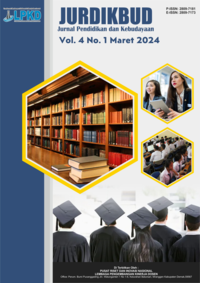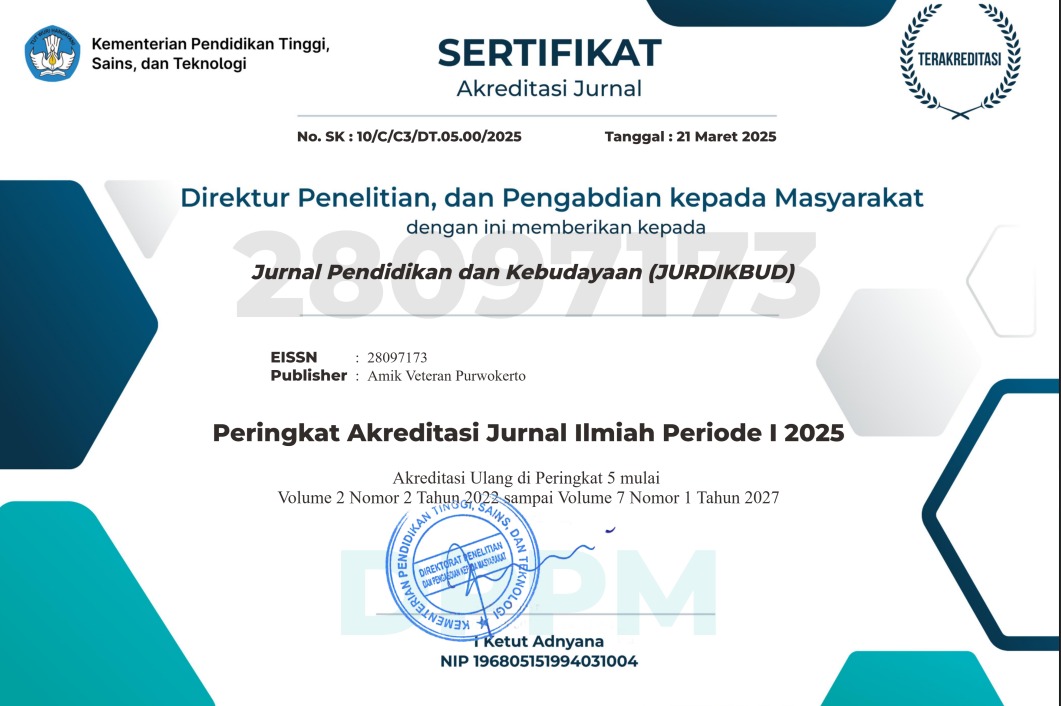Utilisasi Animasi Bergerak Berbasis Artificial Intelligence (AI) Sketch Metademolab Sebagai Pengembangan Kreativitas dan Imajinasi Peserta Didik SDN 1 Sukorejo Nganjuk
DOI:
https://doi.org/10.55606/jurdikbud.v5i2.7977Keywords:
Creativity, Imagination, Tecnology Artificial IntelegenceAbstract
AI technology, which is currently widely used, can be used as a medium to foster students' enthusiasm for drawing and creativity. One that can be used is AI technology in the form of moving or giving motion effects to drawings made by students. In addition to developing students' imagination and creativity, this research activity can also improve teachers' abilities to become good and innovative teachers. Current problems are declining student interest in creating works, and a lack of teacher training regarding the use of technology in learning. The research conducted was by guiding children to draw illustrations of characters or something based on their imagination. Next, students were directed to upload the results of the drawings on the Sketch Demolab page and then students viewed them. The resulting image became a moving animation. The research was conducted to obtain data on student enthusiasm in creating works. The results showed that the use of Artificial Intelligence (AI) Technology Sketch Metademolab in effective moving animation activities can increase students' creativity and imagination. This was obtained from the results of questionnaires and interviews conducted with students at SDN Sukorejo 1. The results showed that students responded positively to this activity, with an average percentage of "YES" answers above 90%. This reflects that a learning approach based on creative practices such as drawing and animation is able to create a fun and meaningful learning experience. In addition, the use of AI technology in learning has been proven to have a positive impact in supporting the learning process of students, especially in honing critical thinking skills, imaginative, and adaptive to the development of the times. In addition, the use of AI technology in learning also provides an opportunity for students to better understand how technology can be applied in the world of art and creativity.
References
Afif, M., & Aminullah. (2013, Agustus). Kecemasan antara Peserta Didik smp dan santri pondok pesantren. Jurnal Ilmiah Psikologi Terapan, 01, no. 02, 208-209.
Arikunto, S. 2002. Metodologi Penelitian Suatu Pendekatan Proposal. Jakarta: PT. Rineka Cipta
Diantama, S. (2023). Pemanfaatan Artificial Intelegent (AI) Dalam Dunia Pendidikan. DEWANTECH Jurnal Teknologi Pendidikan, 1(1), 8-14. https://doi.org/10.61434/dewantech.v1i1.8
Hidayati, R. A. (2020). Hubungan Peran Teman Sebaya Dengan Perilaku Bully Pada Remaja Di Smp Negeri 3 Gamping Sleman Yogyakarta. Skripsi Sarjana. Universitas 'Aisyiyah Yogyakarta. Yogyakarta.
Kidd, F, R. (1983). Advisory Editor : Lubis, N. A. A. (2022). Meningkatkan Kreativitas Peserta Didik Sekolah Dasar melalui Karya Seni Rupa Menggambar Imajinatif Nurasiyah Anas Lubis Sekolah Tinggi Agama Islam Hikmatul Fadhillah Medan. Jurnal Pendidikan Guru Sekolah Dasar, 3(2), 15-25.Dwi Steffany B, "Implementasi Tata Tertib Peserta didik Di SMP Pertiwi 1 Kota Jambi," Universitas Jambi, Jambi, 2024. https://doi.org/10.33487/mgr.v3i2.4114
Lestari, S., Rakhmawati, A., & Rohmadi, M. (2017). Analisis Unsur Intrinsik Dan Ekstrinsik Pada Kumpulan Cerpen Pilihan Kompas 2014 Serta Relevansinya Sebagai Materi Pembelajaran Sastra Di Sekolah Menengah Atas. BASASTRA, 4(1), 183-202.
Lestari,dkk.(2024). Penerapan AI dalam Pembelajaran untuk Meningkatkan Kualitas Pendidikan di SMAN 3 Bukitinggi.vol.4.no.1 hal 278-288
Marwati, A. W., Rokayah, C., & Herawati, Y. (2020). Pengaruh progressive muscle relaxation terhadap skala nyeri pada pasien post sectio caesaria. Jurnal Ilmu Keperawatan Jiwa, 3(1), 59-64. doi:10.32584/jikj.v3i1.472 https://doi.org/10.32584/jikj.v3i1.472
Moelong, L.J, (2017). Metodologi Penelitian Kualitatif. Bandung: Rosda Karya
Nafisah, dkk. (2024). Penggunaan Teknologi Artificial Intelligence Untuk Peningkatan Pembelajaran Pada SMA Nurul Iman Palembang Menggunakan ITIL V3. Jurnal Nuansa Informasi. Vol. 18 Nomor 1 hal 34-40 https://doi.org/10.25134/ilkom.v18i1.40
Niland, A. (2023). education sciences Picture Books , Imagination and Play : Pathways to Positive Reading Identities for Young ChildrenErtikanto, Teori belajar dan pembelajaran. Yogyakarta media akademi, 2016 https://doi.org/10.3390/educsci13050511
Robiul, D., Arya, I., & Zakariyya, A. (2023). Manfaat Kecerdasan Buatan Untuk Pendidikan. TEKOPIN (Teknologi Komputer dan nformatika), 2(1), 124-134 https://doi.org/10.59820/tekomin.v2i1.163
Sugiyono, (2021). Metode Penelitian Kuantitatif Kualitatif dan R&D (M.Dr. Ir. Sutopo, S.Pd (ed); ke2 ed)
Termini,K.A., & Golden, J.A. (2007). "Moral Behaviors: What Can Behaviorsts Learn from the Developmental Literature?". International Journal of Behavioral Consultation and therapy volume 3, No.4 https://doi.org/10.1037/h0100818
Turban, Efraim, 1995, Decision Support System and Expert System, 4th ed., Prentice-Hall, Inc., New Jersey, pp 472-679
Yahya, dkk (2024). Pemanfaatan AI sebagai Media Pembelajaran dalam Pendidikan Ekonomi. Jurna Disrupsi Bisnis, Vol. 7 no.6 hal. 823-830.
Downloads
Published
How to Cite
Issue
Section
License
Copyright (c) 2025 Jurnal Pendidikan dan Kebudayaan (JURDIKBUD)

This work is licensed under a Creative Commons Attribution-ShareAlike 4.0 International License.








